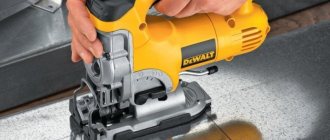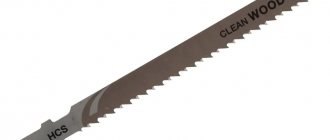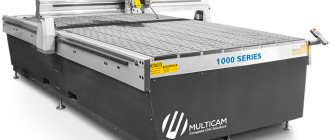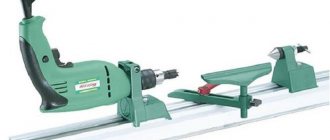A jigsaw allows a craftsman to significantly speed up the process of sawing wooden blanks, plywood sheets, chipboard, OSB, plastic, thin metal, etc. Choosing the owner of a jigsaw that meets all the requirements is a rather complex and responsible process, especially if there is a need to meet the budget allocated for the purchase . From this publication you will learn how to wisely choose a reliable jigsaw, learn about the design and functional features, advantages and disadvantages of the most popular models.
Jigsaw design
At its core, an electric jigsaw is a fairly simple device in which the rotation of an electric motor shaft is converted into a reciprocating motion of the saw blade. Regardless of functionality and design, the device consists of several structural elements:
- Housing with handle, trigger and device controls;
- Sole;
- Electric motor with gearbox;
- Saw blade;
- Pipe branch.
Jigsaw device
Let's look at some design elements in more detail.
Body with handle
The device body is made of plastic resistant to mechanical damage and temperature effects. There are ventilation grilles on the sides of the case. The handle is part of the body structure and can be made in two versions:
- staple-shaped;
- mushroom-shaped.
Mushroom handle Bracket handle
According to most users, the staple handle is more convenient when making straight cuts; mushroom-shaped - for curvilinear cutting of sheet materials.
Advice! When choosing a device, pay attention to models whose handles are made of non-slip materials.
Sole
The supporting platform, popularly called the “sole,” is made of metal. Depending on the model and class of the tool, it can be cast or made by stamping.
The sole of the jigsaw is made of metal
The advantage of cast platforms is their strength, which results in resistance to deformation, which significantly improves cutting accuracy. The disadvantage is the high cost, which significantly affects the final price of the product.
Stamped “soles” are used in models of the budget class and mid-price segment. Despite the significantly lower strength characteristics, it is extremely difficult to deform the stamped support platform during proper operation of the device.
Saw blade and locking mechanism
Depending on the type, rigidity and structure of the material being processed, jigsaws use saw blades that differ in thickness, width, tooth pitch and shape, and type of shank.
Jigsaw saw blades
When choosing a file, first of all, you should pay attention to the mechanism for attaching it to the jigsaw, which can be:
- Collet or block. The fixation mechanism is a block with a slot and two front-mounted clamping screws. Among the advantages are the fastening of saw blades of any size. The disadvantage is the possible distortion of the file due to uneven tightening of the pressure block;
- The blade is fixed in the mechanism with one side clamping screw. Advantages: ease of fastening, ability to install nail files with any shank shape. Disadvantages: possible distortion of the saw blade if installed incorrectly in the mechanism;
- Quick release fastener. To change files and attach them, no additional tools are required. Advantages: convenience and high speed of replacing consumables. Disadvantages include questionable reliability and compatibility with blades only with a certain shank shape.
Saws for different materials
Dust collector pipe
Most modern models are equipped with a connection pipe for connecting a vacuum cleaner hose, a special bag or a cyclone filter. The pipe can be made as a removable element or be an integral part of the housing structure.
Characteristics of jigsaws
Ease of operation and simplicity of design allow the use of an electric jigsaw even by people without experience with such a tool. The main characteristics of the device are:
- Power;
- Blade stroke frequency;
- Type of food;
- Features of the saw stroke;
- Method for replacing the cutting blade;
- Additional equipment.
All these parameters significantly affect the efficiency of the device and are the main criteria when choosing a model.
The marking of the canvas, consisting of numbers and letters, is also the most important characteristic that is applied to the product. It contains important information, including:
- Shank type;
- Canvas size;
- Teeth size;
- Material.
Classes of jigsaws
When choosing a model for home use, you must remember that all jigsaws, however, like other power tools, are conventionally divided into household and professional. Despite their similar design and purpose, they differ significantly in their technical characteristics, capabilities, service life and operation.
Household
Household models are designed exclusively for extremely short and periodic use. These models are used for cutting wood and sheet material (plywood, chipboard, fiberboard, OSB) up to 70 mm thick; metal - up to 4 mm. As a rule, the power of household jigsaws does not exceed 0.5 kW.
Advantages: small weight and size indicators and affordable cost.
Disadvantages: limited resource, rapid overheating.
Professional
Models in this category are designed for sawing wood and its derivatives up to 130 mm thick; sheet materials made of non-ferrous metal - up to 20 mm; steel sheets - up to 10 mm. Continuous use time is no more than 3 hours. The power of the devices varies from 550 to 800 W.
Advantages: increased resource and wider scope of use.
Disadvantages: large mass, significant cost.
Industrial
Industrial jigsaws are stationary machines in which it is not the device that moves, but the material being processed directly. The main advantage of industrial electric jigsaws is their ability to work up to 24 hours a day. If you are faced with the question of which electric jigsaw to choose, then the answer is no, unless you are planning to open a carpentry shop or a furniture business.
Advice! It makes no sense for a home craftsman, regardless of whether he is involved in woodworking, to pay attention to such units: their cost is very far from affordable.
Types of jigsaws
Electric jigsaws are divided into two groups.
- Professional;
- For everyday life.
Each group has its own characteristics, so there are different model options.
What types of jigsaws are there:
- Manual;
- For curly cutting;
- With speed control;
- Tape;
- Mini jigsaw.
More details about each group:
Professional jigsaw
Jigsaws for professional use must meet great requirements, which include:
- Reliability;
- Productivity;
- Functionality;
- Ergonomics.
A professional jigsaw must function effectively even under increased loads and withstand continuous operation for up to seven hours.
Household jigsaw
A jigsaw for household use is relatively inexpensive, easy to use, and has sufficient power. Fully copes with assigned work tasks at home and in the country.
Features of household jigsaws are:
- Low, but sufficient for domestic work, power;
- Additional functions;
- The duration of operation should not exceed twenty hours per month;
- Low price.
Main selection criteria
If you have already decided on the type of device, the design of the saw blade fastening mechanism and the shape of the body, then the next step is to study the technical characteristics.
Power type
Today, jigsaws are widely represented on the domestic power tools market in two power supply options:
- Wired, operate from a household network 200 V/50 Hz;
- From a battery with a voltage of 10.8 V, 12 V, 14.4 V, 18 V and a capacity of 1-4 Ah.
Mains power Cordless jigsaw
When choosing a wired model, always pay attention to the length, cross-section of the cable and the quality of its insulation. If you need autonomy, then purchase cordless jigsaws. However, do not forget that wireless models have much more disadvantages than advantages. The main disadvantage is the limited operating time of the tool on one battery charge.
Power consumption
The capabilities of any electric jigsaw are largely limited by the power of its power unit. The power of devices available for sale today can vary in the range from 350 W to 1 kW:
- A device with a power of 350-400 W can cope with wooden workpieces with a thickness of no more than 65 mm and steel sheets of 2 mm;
- For cutting plywood, fiberboard sheets, MDF, chipboard, plastic, 32 mm thick, metal, 4-5 mm thick, a device with a power of 400-500 W is sufficient;
- A device with a power of 600-750 W can cope with a wooden workpiece 85 mm thick and a sheet of metal up to 8 mm.
Saw stroke
This parameter affects the performance of the jigsaw:
- The value from 15 to 26 mm is the maximum possible stroke of the saw blade;
- A short stroke of 15-17 mm for a tool with low productivity, which, by the way, is quite enough for work in a home workshop;
- A tool with a saw blade stroke of 19-26 mm has high productivity and will be useful in the process of regular production of cabinet furniture or procurement operations on a construction site.
File material
Depending on the purpose, saw blades can be made from:
- Carbon steel. Used for sawing workpieces made of soft wood and artificial materials;
- High speed steel. Used for cutting sheet steel and non-ferrous metals;
- Bimetal. They have an increased resource, tolerate overheating well;
- Diamond coated steel. Used for cutting glass and ceramic tiles.
Jigsaw blade materials
File tail shape
Today, the most common type of saw blade shank for electric jigsaws are:
- T-shaped with one stop (cross). Suitable for most modern models of jigsaws from brands such as AEG, Bosch, Makita, Metabo, Hitachi, De Walt, etc.;
- T-shaped with two stops, used in older Bosch models;
- U-shaped (circle-shaped notch). Files with this shank shape are suitable for all types of jigsaws with a screw or collet clamp;
- L-shaped, used only for Peugeot jigsaws;
- Straight with two holes, used in older Makita models.
Types of saw shanks
engine's type
In modern models of electric jigsaws, two types of motors are used:
- open;
- closed.
When choosing a model for your home, pay attention to devices with a closed motor design. The open type of engine is susceptible to dust, which clogs the armature, which adversely affects the operation of the tool.
Maximum stroke rate
For a knowledgeable person, the stroke frequency of the rod characterizes the quality of the cut and the operating speed of the tool. For most models, this parameter varies in the range from 2500 to 3700 strokes/min. The stroke frequency of the rod for the most popular jigsaws is in the range of 3000-3200 strokes/min.
Cutting depth
The depth of the cut depends on the power of the jigsaw, the type of saw blade and the type of material being processed. Manufacturers in the jigsaw documentation indicate several values for the permissible cutting depth: for wood, aluminum and steel.
The depth of cut depends on the power, type of saw blade and type of material
For devices belonging to the class of household tools, this parameter is in the range of 40-160 mm for sawing wood and 5-10 mm for non-ferrous metals.
Presence of a pendulum
All modern models of jigsaws are equipped with a pendulum stroke. The presence of a pendulum, or, as it is popularly called, a “swing,” allows you to significantly increase the sawing speed, often at the expense of reducing the quality of the cut. It is necessary to “swing” the blade when it is necessary to cut a large volume of wooden blanks. In other words, when speed is important, not cleanliness and precision of the cut.
Pendulum stroke
Speed adjustment
Many models have the ability to adjust the engine speed and, accordingly, the stroke of the rod. This useful feature allows the operator to process materials of different densities and viscosities with the highest quality. The harder the material, the lower the speed of the saw blade should be. Wood requires maximum speed, metal requires minimum.
Depending on the design, adjusting the speed of the jigsaw motor for different models of jigsaws can be done in two ways:
- The required speed is set with a special switch before starting work;
- The speed of the saw blade is adjusted during operation by pressing the start button.
If you often have to cut various materials, then you should pay attention to a device with speed control. For continuous work with the bottom material, this function is not mandatory.
Method of fastening the canvas
The design of the fixation mechanism assumes the use of the following as the main fastening element:
- screws;
- clamping device.
The screws allow you to secure files with any shank configuration, but require a screwdriver or hex socket wrench. The clamping device is designed to hold specific saw blades, but does not require a tool. What type of instrument you choose is a matter of taste and the availability of the necessary consumables.
Ease of use
What else should you pay attention to when choosing a jigsaw? On options that determine the convenience of regular use of the device:
- Handle shape: C-shaped greatly simplifies straight cutting of material in a horizontal plane. Mushroom-shaped allows you to better perform figured cuts and sawing material at an oblique angle;
- The presence of a case allows you to keep the instrument in order. This is especially important if it needs to be transported regularly;
- Device weight. Most models weigh between 1 and 3 kg. The mass of the device exerts pressure on the material being processed, subjecting it to deformation. Based on this, to work with thin sheets of fiberboard, metal or plastic, you need to choose a device with a mass of 1-1.5 kg. To work with thick material, pay attention to models weighing from 1.5 to 3 kg.
General information about jigsaws
To use a jigsaw (for example, such as the Makita JV0600K), you do not need any special knowledge or skills. This device has a simple design and operates at the touch of a button. You can get to know the tool better by understanding its structure and operating principle.
Jigsaw device
Regardless of the model, an electric jigsaw has:
- Handle . It is located horizontally, helps to hold the tool while working.
- Motor . Provides direct movement of the file. Has different power. The list of materials that the jigsaw can handle depends on this value.
- File . It is different for each material, with a unique tooth design. It can be made of various types of steel and have additional spraying for rigidity. Responsible for the accuracy and precision of the cut, as well as the correct angles when sawing.
- Base plate . Holds the saw in a given position. You can change the angle of inclination. Some models have an angle gradation scale.
In addition to these basic elements, the device is also equipped with additional functionality designed to facilitate the work of the master. But more on that later.
Principle of operation
As soon as the master presses the start button, the teeth on the blade begin to saw the prepared raw materials. The saw in the tool is installed in such a way that the material is cut when it moves upward. It is held in place with strong clamps and does not slip out of the cut. The support roller acts as a guide in the process, and it also takes on most of the load. This platform is “pressed” into the material, guaranteeing 100% cutting accuracy.
In models that have a pendulum stroke (for example, Bosch GST 90 E), the blade moves not only up/down, but also (slightly) left and right. The range of oscillation of the pendulum is adjusted by a switch.
Important ! Without activating the pendulum stroke, the jigsaw works slower, but the cut is perfect. When the pendulum is turned on, the work time is reduced, but its quality decreases.
Additional functions
- Laser pointer. The laser beam acts as a guide line. There is no need for it if you are used to making markings before cutting the material;
- Possibility of connection to a vacuum cleaner or dust collector. A useful feature that allows you to keep your workplace in order;
- Automatic sawdust blowing allows you to see the marking line as clearly as possible;
- Illumination is important to create maximum visibility of the cutting line, regardless of the position of the device and the operator;
Jigsaw with light - Adjusting the sole is a very useful feature that allows you to cut material at a strictly defined angle. Depending on the class of the tool, the angle of inclination of the support platform can vary by 15, 30 and 45°;
- A soft start ensures a gradual increase in speed by the electric motor. As a result of this, the starting current is reduced, and as a result, the load on the electrical network. In addition, this option is necessary in cases where high cutting accuracy is important;
- Blade replacement system. The saw blade is replaced without keys or screwdrivers;
- The holding mechanism is operated by a plastic lever;
- Maintaining speed under load. This useful option will help maintain the speed and quality of the cut, and also protect the motor from overload.
Auxiliary Tools
In the fight for consumers, jigsaw manufacturers produce a lot of additional tools and accessories designed to make various jobs easier. Among the most popular additional devices are:
- The rip fence is designed for quickly making cuts parallel to the edge;
- The stop-compass allows you to make precise cuts around the circumference;
Compass stop - The guide rail is designed to make cuts perpendicular to the edge;
- The anti-splinter insert is a plate fixed to the support platform that prevents lateral bending of the saw blade;
- The removable pad on the sole prevents scratches on the material being processed.
Features and purpose of a jigsaw
The difference between an electric jigsaw and other similar tools is its increased accuracy when performing work.
A jigsaw can work with a variety of materials. The device can not only saw parts lengthwise, but also make shaped cuts, as well as at a certain angle.
This tool can be used for sawing:
- Ceramics;
- Glass;
- Trees;
- Plastics;
- Metal.
This device is capable of providing the following:
- Increased accuracy;
- Clean edge processing;
- Straight cut;
- Cutting along a complex trajectory;
- Cutting holes of various shapes;
- Cuts workpieces of almost any size.
In the shortest possible time, the jigsaw began to be widely used in everyday life. It is often used when renovating premises; it copes excellently with cutting:
- Drywall;
- Laminate;
- Plywood;
- Ceramic tiles.
Rating of the best manufacturers of jigsaws
Which reliable jigsaw to choose from a huge range of products? A rating of popular models compiled by experts based on reviews from real users will help answer this question.
Budget models
| Model | Characteristics |
| Bort BPS-500-P A convenient and quite functional model for the home at a very reasonable price. Household electric jigsaw with a power of 550 W. Cutting depth: wood - 55 mm; steel - 5 mm. The handle is C-shaped with a rubberized lining. The sole is stamped with an inclination of 45° in both directions. Functionality: 4-stage pendulum mechanism, electronic adjustment of the stroke frequency from 0 to 3000 rpm, fixation of the start button, blowing off sawdust. Weight - 1.56 kg. The average cost is 1400 rubles. Advantages:
Flaws:
| |
| FIOLENT PM3-600E Despite the relatively low cost, FIOLENT PM3-600E belongs to the group of professional instruments. The 600 W motor allows you to cut wood (up to 85 mm thick), fiberboard, sheet plastic, aluminum (up to 20 mm thick) and steel up to 10 mm. The clamping mechanism is a lock with a screw fastening. Functionality: tilting of the support platform by 45° in both directions, 3-stage pendulum mechanism, electronic adjustment of the rod stroke frequency from 0 to 2600 rpm, locking the start button, blowing away sawdust. Weight - 2.5 kg. Supplied with a plastic sole plate. The average cost is 2900 rubles. Advantages:
The disadvantage is the significant weight of the device. | |
| Bosch PST 700 E A simple, reliable and convenient jigsaw for high-quality cutting of various materials. The 500 Watt motor allows you to easily make cuts in wood up to 70 mm deep. This model features a Low Vibration vibration damping system. The SDS quick-release mechanism allows you to quickly change working blades without using additional tools. The handle is C-shaped with a rubberized lining. Functionality: tilt of the support platform by 45° in both directions, 3-stage pendulum mechanism, push-button adjustment of the rod stroke frequency from 500 to 3100 rpm, fixation of the start button, blowing off sawdust, connection for connecting a vacuum cleaner. Weight - 1.6 kg. The average cost is 3600 rubles. Advantages:
Flaws:
|
Middle price segment
| Model | Characteristics |
| STAVR LE-110/900L STAVR LE-110/900L is the most powerful model in this category, which can do almost everything. Engine power - 900 W. Cutting depth: wood - 110 mm, aluminum - 20 mm, steel - 10 mm. The handle is C-shaped, rubberized. The sole is cast aluminum with an inclination of 45° in both directions. The stroke length of the rod is 24 mm. A special feature of this model is the cast gear housing and the lowest possible location of the support roller, ensuring minimal backlash. Functionality: 4-stage pendulum mechanism, tilt of the support platform by 45° in both directions, electronic adjustment of the stroke rate from 500 to 3000 rpm, locking of the start button, blowing off sawdust, laser marker, dust extractor with the ability to connect a vacuum cleaner. Contents: 2 hex keys, parallel stop, saw blade for wood, metal and plastic, protective cover, vacuum cleaner nozzle, carbon brushes, saw blade for plastic Weight - 3.04 kg. The average cost is 5200 rubles. Advantages:
Flaws:
| |
| Bosch PST 900 PEL A model that combines high performance typical of professional equipment and excellent ergonomics of household devices. The motor power of 650 W is enough for confident work with various materials. Cutting depth: wood up to 90 mm thick, fiberboard, sheet plastic, aluminum up to 15 mm thick, and steel up to 8 mm. Functionality: tilting of the support platform by 45° in both directions, 4-stage pendulum mechanism, adjustable rod stroke frequency 500-3100 strokes/min, built-in lighting, sawdust blowing function, possibility of connecting a vacuum cleaner. This model features a Low Vibration vibration damping system, a quick-release mechanism for securing the saw blade, and a built-in compartment for files. Case included. Weight: 2.2 kg Average cost 5600 rub. Advantages:
Flaws:
| |
| MAKITA JV0600K An excellent professional electric jigsaw with thoughtful ergonomics at an affordable price. The 650 W motor allows you to cut wood up to 90 mm thick, fiberboard, sheet plastic, aluminum up to 20 mm thick, and steel up to 10 mm. The saw stroke is 23 mm. The model uses a quick-release mechanism for fixing the saw blade. Molded sole. The handle is staple-shaped with rubberized inserts. Functionality: tilting of the support platform by 45° in both directions, 3-stage pendulum mechanism, electronic adjustment of the rod stroke frequency from 500 to 3100 rpm, fixation of the start button, blowing off sawdust, dust extraction pipe for connecting a vacuum cleaner. Weight - 2.4 kg. Supplied with a plastic case. The average cost is 6,500 rubles. Advantages:
No deficiencies found. |
Premium models
| Model | Characteristics |
| Makita 4351 FCT Professional-grade tool with low noise and vibration levels for comfortable long-term work. Power - 720 W. The saw stroke is 26 mm. Cutting depth: wood - 135 mm; steel - up to 10 mm. The handle is mushroom-shaped with a rubberized lining. The sole is cast with an inclination of 45° in both directions. The device uses a quick-release fastening of the file. Functionality: 4-stage pendulum mechanism, electronic adjustment of the stroke frequency from 800 to 2800 rpm, soft start, function of maintaining speed under load, backlight, anti-vibration system, dust extraction pipe. There is a special pad on the sole to protect the workpiece from scratches. Weight - 2.4 kg. Equipment: case. The average cost is 10,300 rubles. Advantages:
The disadvantage is the high price. | |
| DeWalt DW331K A powerful professional model to solve any problem. The 700 W motor allows you to easily saw wood up to 135 mm thick and aluminum up to 30 mm thick. The working equipment can be easily changed thanks to the quick-clamping mechanism for fixing the file. Functionality: 4-stage pendulum mechanism, electronic adjustment of the rod stroke frequency from 0 to 3100 rpm, soft start, keyless sole tilt adjustment up to 45° in both directions, anti-vibration system, function of maintaining speed under load. Feature: Modular design for easy access to key tool components. Weight - 2.8 kg. The average cost is 11,500 rubles. Advantages:
Flaws:
| |
| BOSCH GST 14.4 V-LI Professional Extremely compact and productive cordless jigsaw. High performance and operating time on a single charge are ensured by a capacious battery with a voltage of 14.4 V and a capacity of 4 A/h. The saw stroke is 23 mm. The quick-release saw blade system does not require additional tools. The model implements technologies for safe blade replacement with saw blade extension and parking position, Electronic Motor Protection protects the engine from overload, Electronic Cell Protection protects the battery from overload. Functionality: 4-stage pendulum movement, soft start, sole tilt adjustment up to 45° in both directions, backlight. Equipment: case, network charger, two batteries, protection against chipping, 3 saw blades for various types of material. The average cost is 25,000 rubles. Weight - 2.3 kg. Advantages:
There are no disadvantages. |
Tips for choosing
- Decide on the purpose and scope of use of the tool. In most cases, a household or semi-professional model in the mid-price category is sufficient for home use;
- The higher the power of the device, the greater its mass. Think several times whether you are ready to physically work all day with a heavy tool;
- For home and garden use, pay attention to models with a D-shaped handle. It is much more convenient and provides greater accuracy of straight cutting when operated with one hand;
- Choose a tool with a saw blade speed control if there is a need to work with different materials;
- The quick-release locking mechanism often requires “original” saw blades, which may not be on sale at the most inopportune moment. As practice has shown, the most unreliable mounting option is a block with a slot and two screws. A universal option is a key lock or a screwdriver.
Watch a video on how to choose a jigsaw
Types of electric jigsaws
Compact home jigsaws are divided into the following categories:
1. By type of food:
- rechargeable ones are convenient due to their mobility, but require regular recharging.
- from the network - there is a “attachment” to the outlet, but the power is supplied uninterruptedly.
2. According to the shape of the handle:
- staple type - the most common type; during operation, the tool is held with one hand;
- mushroom-shaped - the handle provides for holding the unit with two hands, thereby guaranteeing the smoothest possible cut, without burrs.
When using mushroom-shaped jigsaws (example: Sparky FSPE 110 HD), it is important to ensure preliminary and high-quality fixation of the material being processed, just like when working with a drill.
You might also be interested in: Unconventional use of a drill: 4 interesting life hacks











